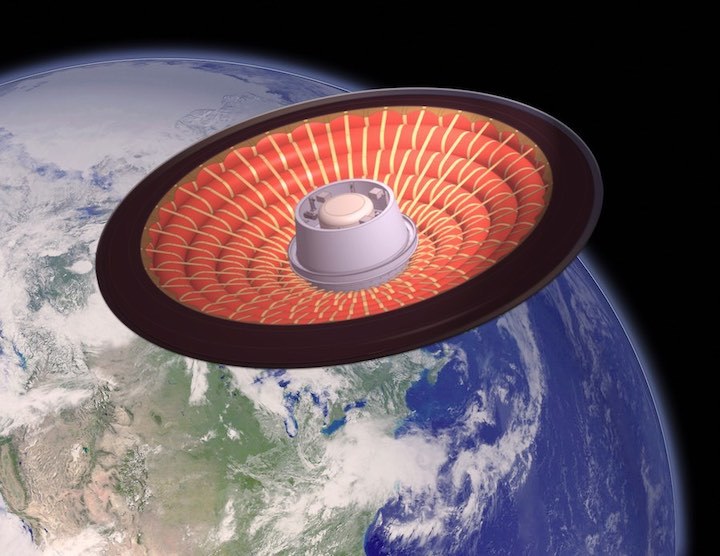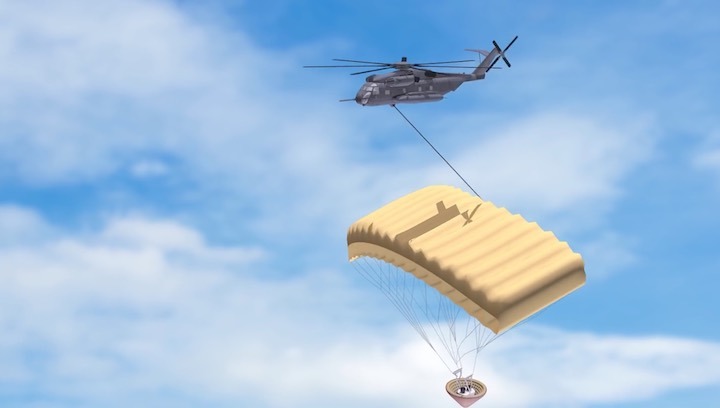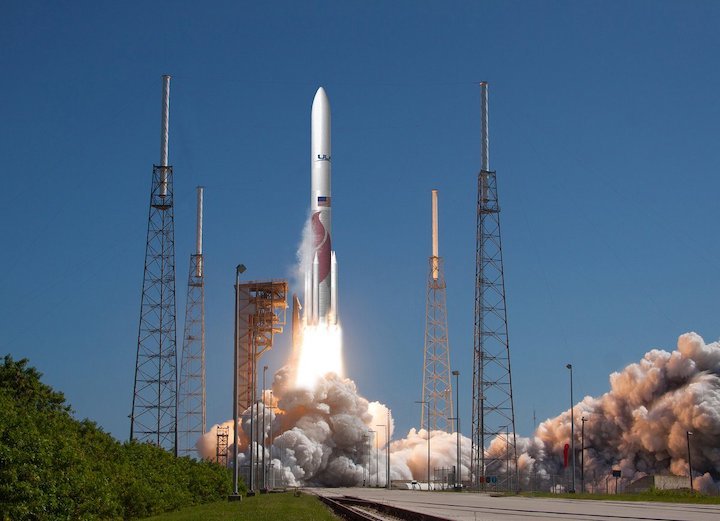14.05.2019

A flight demonstration of an inflatable heat shield that could be used to retrieve reusable engines from United Launch Alliance’s next-generation Vulcan rocket, and for the delivery of heavier cargo to the surface of Mars, is planned for launch in late 2021 or early 2022 as a piggyback payload on an Atlas 5 rocket with a NOAA weather satellite.
The inflatable re-entry decelerator will launch as a joint project between NASA and ULA, which foresee different uses for the technology.
ULA aims to recover engines from the company’s new Vulcan rocket, set to debut in 2021, using an inflatable heat shield and a parafoil. A helicopter equipped with a boom will snag the parafoil in a mid-air recovery, preventing contamination from salt water if the engines splashed down in the ocean.
The inflatable heat shield is much lighter than a rigid heat shield, such as thermal protection systems used on crew capsules, and take up less volume inside a rocket’s payload fairing. The technology will allow future NASA missions to deliver more massive rovers, landers, and eventually human-rated habitats to the Martian surface.
The heaviest spacecraft ever landed on Mars using current technology was the Curiosity rover, which weighed less than a ton at touchdown in 2012.
Inflatable heat shield technology could also protect materials manufactured in space during the return trip to Earth.
“It has the potential for returning substantial mass back to Earth,” said Jim Reuter, associate administrator of NASA’s space technology mission directorate, during an April 30 meeting of the NASA Advisory Council’s technology, innovation and engineering committee.
The Low Earth Orbit Flight Test of an Inflatable Decelerator will test a nearly 20-foot-diameter (6-meter) heat shield, the largest blunt body atmospheric entry vehicle ever flown in space.
NASA and ULA have identified room for the re-entry testbed, known by the acronym LOFTID, as a secondary payload on an Atlas 5 launch in late 2021 or early 2022 from Vandenberg Air Force Base, California, with NOAA’s Joint Polar Satellite System-2, or JPSS 2, weather observatory heading for polar orbit, according to Reuter.
Officials said NOAA recently agreed to launch the LOFTID experiment with the JPSS 2 satellite, after a search for excess capacity on Atlas 5 missions launching from Vandenberg over the next few years.
Therese Griebel, deputy associate administrator for programs in NASA’s technology division, said a recent review with JPSS 2 program managers concluded the addition of the LOFTID experiment on the launch would add no significant risk to the mission.
“It looks like we’ve gotten everybody on-board (with launching LOFTID with JPSS),” Reuter said.

The JPSS 2 satellite has a targeted launch readiness date in the first quarter of fiscal year 2022, or late in the calendar year 2021, according to John Leslie, a NOAA spokesperson.
NASA, which provides launch and spacecraft development support to NOAA’s weather satellites, selected ULA’s Atlas 5 rocket in 2017 to carry the JPSS 2 spacecraft into orbit. The lightest version of the Atlas 5 rocket, a variant known as the Atlas 5-401 without any solid rocket boosters, will launch the JPSS 2 satellite.
But JPSS 2 fills less than half of the Atlas 5-401’s capacity to the weather satellite’s 512-mile-high (824-kilometer) orbit, leaving ample room for secondary payloads.
Last year, NOAA released a request for information soliciting ideas for small commercial Earth observation satellites that could ride piggyback on the JPSS 2 launch. With agreement from NASA, NOAA and ULA, part of the excess capacity on the Atlas 5 rocket will be filled with the LOFTID experiment.
The LOFTID re-entry vehicle will weigh around 2,700 pounds (1,224 kilograms).
Under the terms of a no-funds-exchanged Space Act Agreement, NASA will provide the re-entry vehicle and its inflatable aeroshell. ULA will supply the high-pressure tanks to inflate the heat shield in space and the Atlas 5 launch services at no cost to NASA.
NASA’s Langley Research Center in Virginia heads the agency’s work on the LOFTID experiment.
NASA awarded ULA a separate $1.9 million contract last year to demonstrate mid-air retrieval of the LOFTID entry vehicle, using an ocean-going ship capable of transporting a helicopter to the recovery zone.
The LOFTID experiment will test a flexible thermal protection system using braided synthetic fibers that are 15 times stronger than steel, according to a NASA fact sheet. Unlike rigid heat shields, the material allows the structure to be folded and packed in a tighter volume that can fit inside the payload envelope of existing rockets.
During the LOFTID demonstration, the heat shield will inflate after the Atlas 5 rocket releases the JPSS 2 spacecraft in orbit. After inflation, the Atlas 5’s Centaur upper stage will execute a deorbit burn on a trajectory heading back into the atmosphere, then deploy the LOFTID vehicle for re-entry.

ULA’s interest in inflatable heat shield technology stems from the company’s plan to recover first stage engines from the next-generation Vulcan rocket for refurbishment and reuse.
The Vulcan rocket is scheduled for its inaugural launch from Cape Canaveral in 2021. Two BE-4 main engines, built by Blue Origin, will power the Vulcan’s first stage.
Unlike SpaceX, which lands entire Falcon 9 first stage boosters to be reused, ULA plans to jettison the BE-4 engine pod from the base of the Vulcan first stage. The engines will be shielded by an inflatable decelerator, similar to the system to be demonstrated by the LOFTID experiment, then unfurl a steerable parafoil for a helicopter to capture in mid-air.
The BE-4 engines, which burn methane and liquid oxygen, are designed to be reusable. Blue Origin’s own New Glenn rocket, also set for a debut in 2021, will also use BE-4 engines on its first stage. Like SpaceX, Blue Origin intends to land the New Glenn’s first stage intact for refurbishment and reuse.
ULA will discard the BE-4 engines on the initial flights of the Vulcan rocket. The company plans to begin retrieving the engines around 2024.
Quelle: SN

